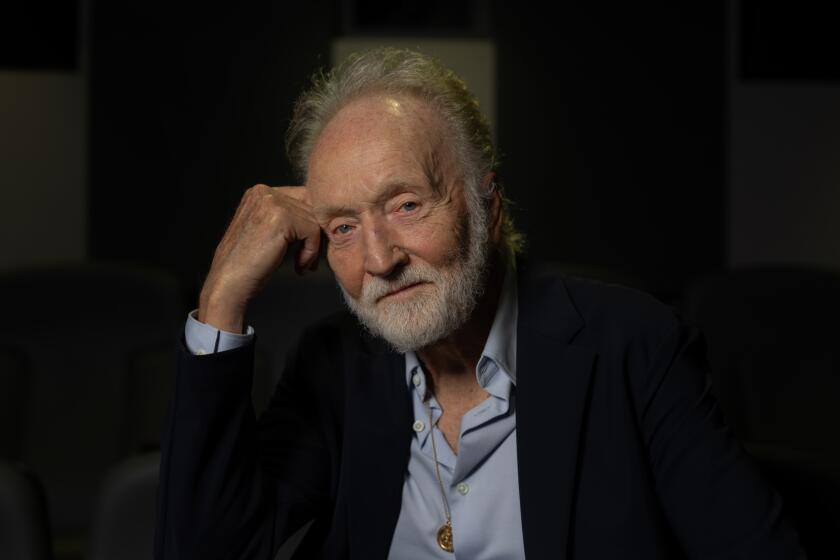Films like ‘Goat’ and ‘White Girl’ reflect a growing fascination with drunk and drugged youth
In the opening sequence of the indie bullying drama “Goat,” Nick Jonas obliterates any vestige of his Disneyfied boy-band past by demonstrating a voracious hunger for drugs, alcohol and freaky sex.
Portraying a party-hearty fraternity brother in the movie (which premiered at the Sundance Film Festival this year and hit theaters Sept. 23), the singer-turned-actor sniffs “bumps” of cocaine, guzzles beer like Evian and arranges an ambitious sexual liaison.
Chronicling an escalating series of frat boy hazings that go horribly, irreversibly wrong, “Goat” provides a searing indictment of bro culture at its most toxic with scenes of dusk-till-dawn ragers, blackout drinking binges, habitual degradation of women and the forced consumption of oceanic quantities of liquor as a means of asserting the pledges’ burgeoning ideal of manhood.
“Young men are just pulsing with this pent-up male energy,” says “Goat’s” director/co-writer Andrew Neel. “They work their way into a bacchanalian fugue state in which they can investigate — and immerse themselves in — the overwhelming biological soup that is consuming their brains and their [reproductive organs]. Not just in fraternities, in all college experiences in the United States, heavy drinking and drugging is the norm.”
“Goat” is hardly the only film reaching multiplexes and streaming services these days to reflect that reality. Provocative titles such as “White Girl,” the Cannes Film Festival jury prize-winning “American Honey” and Netflix’s “XOXO” all draw visceral impact from their depictions of of dissolute young people taking leave of their senses via booze and drugs. They arrive as the latest evidence of a growing public appetite for drinking and drugging as entertainment.
Moreover, in an era when the legalization of marijuana in some states has led to an institutionalized acceptance of recreational drug use and in which binge drinking is a regular part of college life, this crop of new movies reflects popular culture’s current fascination with the spectacle of wasted youth.

Nick Jonas and Ben Schnetzer star in “Goat,” a film directed by Andrew Neel that takes a hard look at the male culture through the lens of fraternity hazings.
Of course, “American Honey,” “White Girl” and “Goat” are hardly the first or even the most extreme examples of what we can call the Cinema of Adolescent Overindulgence. (Director Larry Clark’s 1995 youth-gone-wild opus “Kids” likely deserves the latter honor.) But they all manage to steer clear of the type of overt, substance-abuse-is-the-road-to-ruin moral posturing found in such films as 1988’s “Clean and Sober,” director Darren Aronofsky’s narco nightmare “Requiem for a Dream” (2000), 1995’s “The Basketball Diaries” (featuring a teenage Leonardo DiCaprio as a homeless heroin addict) and the dipsomania drama “Days of Wine and Roses” (1962).
Further, they come at a time when weed-centric TV shows are literally and figuratively fogging the airwaves — MTV’s “Mary + Jane” and HBO’s “High Maintenance” began airing in September, soon to be joined by show runner Chuck Lorre’s marijuana dispensary comedy “Disjointed” on Netflix and the John Malkovich-starring “Humboldt” from Sony Pictures Television. In pop music, the Top 40 is packed with drug-themed pop hits: Lana Del Rey’s “High by the Beach,” “Can’t Feel My Face” by the Weekend, Travis Scott’s “Antidote” (with its indiscreet shout-out to “Cocaina!” and memorable refrain, “Poppin’ pills is all we know”).
And by depicting the ways in which young lives are shaped by drinking and drugging — among an onslaught of competing influences including race, gender construction and social privilege — none of the movies can be reduced to a take-away as simple as Just Say No.

Nick Jonas and James Franco star in the trailer for “Goat.”
To hear Neel explain it, hard partying functions as a kind of coping mechanism for young adults in general but especially so for the frat brothers in his film who are basically struggling with the chaos accompanying adulthood’s onset.
“Being young is scary,” he says. “Learning who you are and navigating the whole social environment that you’re becoming a part of is scary. Alcohol, obviously, makes us more uninhibited.”
Less than one minute into writer-director Elizabeth Wood’s blistering coming-of-age drama “White Girl” bleached-blond twentysomething protagonist Leah (Morgan Saylor) inhales deeply on a pipe filled with marijuana. From there, the character channels every ounce of her hedonistic self-determination to party like a rock star — at least until circumstances dictate that she can’t party like that anymore.
After romantically hooking up with her friendly neighborhood drug dealer, she snorts cocaine in nightclub bathrooms and has sex on rooftops; she downs whiskey and smokes blunts with Wiz Khalifa-like gusto. In one now-notorious sequence, Leah even consumes hard drugs off another character’s genitalia.
According to Wood, all that substance abuse is intended to underscore her characters’ naive sense of racial privilege (“white girl” is street slang for cocaine, after all). “These young people — the white girls especially — say yes to everything,” Wood notes. “They are feeling no limits and endless optimism and invincibility. Just going anywhere at any time without worrying about any consequences. And drugs are just one part of the equation.
“The boys who sell drugs don’t do [cocaine] because they’re much more aware of the consequences,” the filmmaker continues. “In my experience, those who come from a more privileged background are more willing to take risks and to try to feel pain and try to feel alive. It’s a result of privilege in this film that these young people are just willing to try anything at any time.”
Christopher Louie, writer-director of the candy-hued, electronic dance music-saturated “XOXO” (a Netflix original that began streaming in August), likes to describe his debut feature as “‘Dazed and Confused’ at a rave” — explicit homage to Richard Linklater’s 1993 dramedy that has matured into a classic of the wasted youth movie canon.
Following the intertwining story lines of six disparate characters whose destinies converge at an all-night EDM extravaganza, “XOXO” showcases scenes of young revelers powering back shots of alcohol, blissed out — and feverishly making out — thanks to unspecified chemical highs as well as suggestively jiggling “Molly” tablets (a.k.a. the club drug MDMA).
Would-be music manager Tariq (Brett DelBuono) finds his consciousness imploding after a loved-up festival attendee French-kisses LSD onto his tongue. Amid the thudding beats and suffocating crowds, he proceeds to hallucinate his own death before hilariously plunging head-first down a port-a-potty (a cinematic tribute to yet another cult movie classic focused around young people doing way too many drugs: 1996’s “Trainspotting”).
The millennial road-drama “American Honey” (which stars Shia LaBeouf and Sasha Lane and hit theaters over the weekend) follows a group of teenage dropouts who traverse the Midwest selling magazine subscriptions and chasing cheap thrills. The so-called “mag crew” gets high and drunk before, during and after the job, sharing bottles of discount vodka and doing massive bong hits in the back of their Ford passenger van as it speeds between cities.
Lane — who was discovered by “American Honey” writer-director Andrea Arnold while partying on the beach in Panama City, Fla., and had never acted before the production — calls “Honey” an accurate depiction of youth culture’s “no judgment” attitude toward drugs and alcohol. (And in separate interviews, the film’s cast of fellow non-professional actors have suggested that the partying onscreen wasn’t even necessarily an act.)
“What I did before I even met [the cast] was chill in parking lots and drink, smoke, whatever. I never saw that as a bad thing,” Lane says. “The movie is unapologetic! The drinking, the smoking and everything — we are living our lives. We have nothing left to lose. Whatever. Let us do what we do. People tend to ignore us anyways. It’s a part of youth. It isn’t a dark thing at all. If we want to hit that joint, let us … hit that joint! Chill.”
Movie Trailers
More to Read
Only good movies
Get the Indie Focus newsletter, Mark Olsen's weekly guide to the world of cinema.
You may occasionally receive promotional content from the Los Angeles Times.











